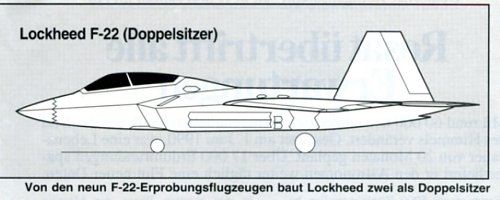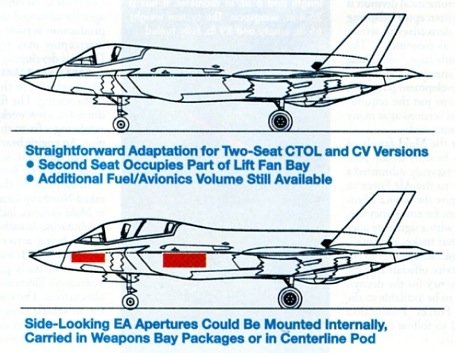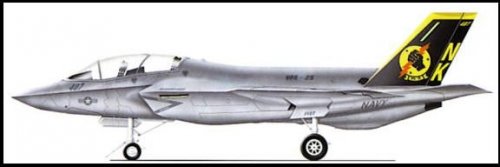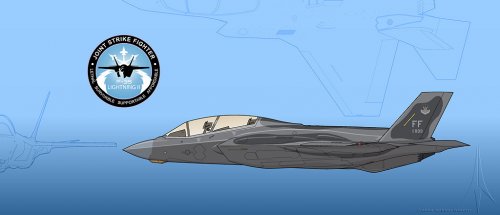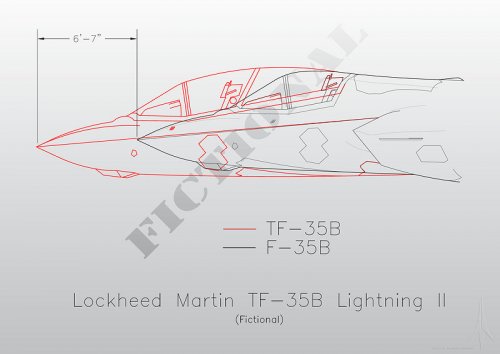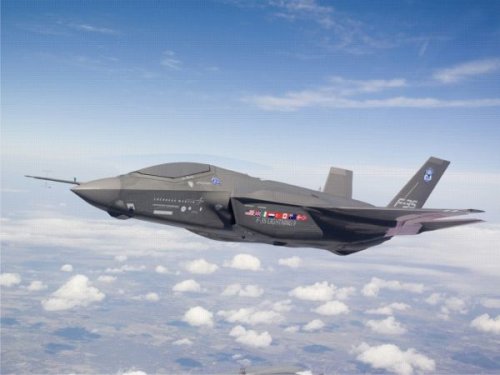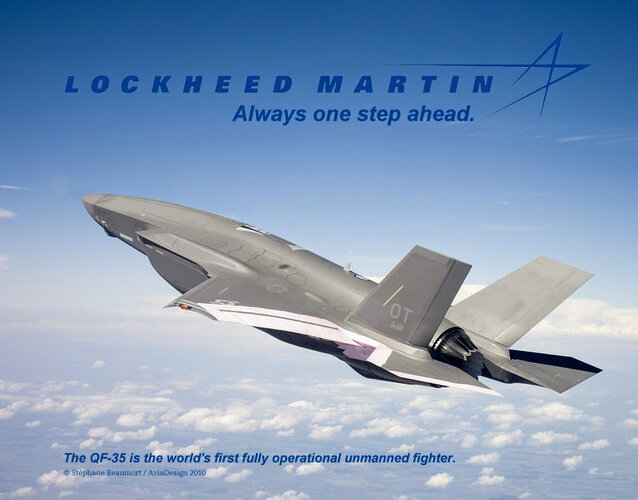You are using an out of date browser. It may not display this or other websites correctly.
You should upgrade or use an alternative browser.
You should upgrade or use an alternative browser.
F-22 and F-35 double seaters
- Thread starter Antonio
- Start date
Is the F-35 one supposed to be real or an artist's speculative design? I'm pretty certain there is, nor has been no 2 seat F-35 officially.
Regards,
Greg
Regards,
Greg
- Joined
- 22 January 2006
- Messages
- 3,891
- Reaction score
- 1,150
Greg,
The article is "JSF Studied as potential jamming, laser platform" by Edward H. Phillips and David A. Fulghum. On page 34 we can read the following:
Antonio
The article is "JSF Studied as potential jamming, laser platform" by Edward H. Phillips and David A. Fulghum. On page 34 we can read the following:
The company (LMA Co.) also is studying a two-seat JSF version. Mission radius would be reduced by 75 mi. Although modifying the Air Force CTOL and Navy CV versions to accept a second cockpit would not be difficult, stretching the STOVL airplane would present more problems because of the lift fan bay. Although analysis by Lockheed Martin JSF team member BAE Systems indicates a two-seat STOVL aircraft is feasible, "there are considerations, including aerodynamics and weight and balance issues," Beaufait said.
Antonio
Matej
Multiuniversal creator
I think it was AWST drawing, but I am not sure.
- Joined
- 3 June 2006
- Messages
- 2,832
- Reaction score
- 2,503
An additional side view of the double seat F-22B is featured on page iii in the magazine "Air International - F-22 Raptor supplement" from December 1998. The artist is the Mike Badrocke.
See also the thread "F-22B Raptor".
See also the thread "F-22B Raptor".
- Joined
- 2 January 2006
- Messages
- 3,520
- Reaction score
- 3,092
That's purely speculative on my part. I took an F-35A, replaced the the cockpit/canopy with one from the F-35B (the F-35B canopy is a bit shorter), then just extended the bottom line of the canopy up/back at the same angle. Then continued the top curve of the canopy and re-positioned the fuselage fairing behind the canopy and copied the ejection seat and instrument panel back for the second seat. This did mean moving the IFR receptacle some to the rear. I don't know if that works internally or not.
I suppose something similar could be done with the F-35C (I was inspired by the two-seat F-35C profile above, I think there's another thread about the F-35 around here somewhere that also has it). I thought about the F-35B, but with the lift fan behind the cockpit, the forward fuselage would need to be lengthened. Probably would need larger vertical tails, too.
I suppose something similar could be done with the F-35C (I was inspired by the two-seat F-35C profile above, I think there's another thread about the F-35 around here somewhere that also has it). I thought about the F-35B, but with the lift fan behind the cockpit, the forward fuselage would need to be lengthened. Probably would need larger vertical tails, too.
Matej
Multiuniversal creator
Lets say that still far better than 2 seat Harrier.
Double seater derived from F-22 is highly unlikely simply because the F-22 is in fact single purpose fighter. So there is only a need of training, that can be with the state of the art computer technology fully satisfied.
But with the much universal F-35, well, this is the real question for the future. In the electronic jamming variant or attack/strike variant the second crew member should be very handy.
Double seater derived from F-22 is highly unlikely simply because the F-22 is in fact single purpose fighter. So there is only a need of training, that can be with the state of the art computer technology fully satisfied.
But with the much universal F-35, well, this is the real question for the future. In the electronic jamming variant or attack/strike variant the second crew member should be very handy.
- Joined
- 3 June 2006
- Messages
- 2,832
- Reaction score
- 2,503
The TAV-8B Harrier II doesn't look too bad.Matej said:Lets say that still far better than 2 seat Harrier.
If a future F-35 version needs a WSO, he won't be sitting in the cockpit anymore, he will be rather sitting in a comfortable armchair in front of flat screens.Matej said:.....
But with the much universal F-35, well, this is the real question for the future. In the electronic jamming variant or attack/strike variant the second crew member should be very handy.
Like in this picture:

Last edited by a moderator:
Matej
Multiuniversal creator
fightingirish said:If a future F-35 version needs a WSO, he won't be sitting in the cockpit anymore, he will be rather sitting in a comfortable armchair in front of flat screens.
I agree that it can be the general direction of the future development, but to say "he wont be sitting... ...anymore", it reminds me one of the "why do we need fighters anymore, when we have rockets" or "why do we need cannon on board anymore, when we have rockets" statements a few decades ago. We all know, how it ended. I simply don't believe at all that we will not see two seat fighters in the future. For me it is too absolute, too ultimate and too imprudent.
Probably this is the theme for some another thread but I ask: was there ever at least one conflict in modern history, where the remotely piloted advanced planes (such as RQ-1 and higher) were used in a strongly jammed environment against healthy enemy with the good technological base? Because the painful thing is, that someone is able and can simply cut you from the network. And then what?
- Joined
- 18 March 2008
- Messages
- 3,532
- Reaction score
- 721
Matej said:I agree that it can be the general direction of the future development, but to say "he wont be sitting... ...anymore", it reminds me one of the "why do we need fighters anymore, when we have rockets" or "why do we need cannon on board anymore, when we have rockets" statements a few decades ago. We all know, how it ended. I simply don't believe at all that we will not see two seat fighters in the future. For me it is too absolute, too ultimate and too imprudent.
There is a big difference in the relationship between manned fighters and guided missile technology in the 1950s and the relationship between manned fighters and UAV technology in the 21st century. One might as well refer to the debates over the merits of bronze swords and iron swords circa 600 BC.
Considering that an uninhabited aircraft can provide about 10-20 times more combat presence than a manned aircraft (comparing F-35 and X-47B in a theatre mission based on CBAS data) you suffer a huge force disadvantage in persisting in keeping fighter pilots their employment. That's not to mention the many advantages a computer controlled aircraft will have in high intensit ATA and targetting compared to a manned aircraft. All it will take is one war between the robots and the 'Knucks before the fighter pilot goes the way of the horsed cavalry...
Matej said:Probably this is the theme for some another thread but I ask: was there ever at least one conflict in modern history, where the remotely piloted advanced planes (such as RQ-1 and higher) were used in a strongly jammed environment against healthy enemy with the good technological base? Because the painful thing is, that someone is able and can simply cut you from the network. And then what?
Sure intuitive, but realistic? Communications technology has come a long, long way since the 1960s when brute force RF emissions would take out radios. Serbia and Iraq certainly didn’t ignore jamming during their battles with US lead collation. Western forces training doesn’t ignore jamming against UAVs and tries to simulate a very high level red force threat.
But how do you jam a satellite link? How do you jam an advanced directional HF link? You need to get the jammer in between the transmitter and the receiver... So unless you have a jamming aircraft flown by Maverick and Goose with a keen desire to ‘maintain international relations’ you are not going to disrupt that UAV’s SATCOM link. Even with a targeted electronic attack like an AESA generated waveform you need a line of sight to the SATCOM antenna, which is usually pointed up so you need to be above the UAV.
Jamming VHF radio isn’t so easy either and even if you have an effective system its tactical usage is limited. Higher end theatre UAVs typically fly with an ELINT system and would be able to detect and hence stay outside the VHF jamming ‘bubble’ to maintain their line of sight data links. They only have to wait a few minutes outside the bubble for the RF homing missile to show up and take out the enemy jamming system...
That tandem A/C model is particularly fetching and it certainly could come in handy for specialty duties in the future.
A two-seat version of the B model would certainly be the most difficult of the three versions and one wonders if it would be necessary enough to warrant. At least for the USN/USMC, the Growler would certainly be available to handle SEAD for any BG or Marine Task Force facing a serious threat in a combat operation so it seems mostly unncessary. The only real serious candidate for a dedicated two-place specialty B model would be the RN but they don't currently have that capability, haven't made any particular requirements for one, and, doing so now for at most a couple of dozen two-seat Bs would be very costly.
A two-seat version of the B model would certainly be the most difficult of the three versions and one wonders if it would be necessary enough to warrant. At least for the USN/USMC, the Growler would certainly be available to handle SEAD for any BG or Marine Task Force facing a serious threat in a combat operation so it seems mostly unncessary. The only real serious candidate for a dedicated two-place specialty B model would be the RN but they don't currently have that capability, haven't made any particular requirements for one, and, doing so now for at most a couple of dozen two-seat Bs would be very costly.
Iranian F-14A
ACCESS: Restricted
- Joined
- 11 May 2006
- Messages
- 34
- Reaction score
- 7
I think as hard as it would be to produce, I think a USMC/RN two seater is almost a given. If nothing else,for training. VSTOL aircraft require special training, and yes, helicopters help and are part of the course,but nothing compares to a two seat model. Also notice that both the RN and USMC, not to mention the RAF, always keep up on updating their two seat Harriers to the newest mark. An example was the TAV-8s of the USMC. Granted, they did use the TAV-8As after the AV-8B was introduced,however, a TAV-8B was eventually made as the entire fleet of "A" and "C" models could be retired as well as being more on par with the "B" model. For now, the TAV-8Bs will do, but in the future, something will have to step up to take their place just as they did before.
For a two-seat F-35B, the forward fuselage (everything in front of the lift fan) would have to be re-designed. It would add more than 6' to the overall length. Don't know what that would do to the internal layout and center of gravity. Just my idea of what it might look like.
Attachments
- Joined
- 18 March 2008
- Messages
- 3,532
- Reaction score
- 721
Iranian F-14A said:I think as hard as it would be to produce, I think a USMC/RN two seater is almost a given. If nothing else,for training. VSTOL aircraft require special training, and yes, helicopters help and are part of the course,but nothing compares to a two seat model. Also notice that both the RN and USMC, not to mention the RAF, always keep up on updating their two seat Harriers to the newest mark. An example was the TAV-8s of the USMC. Granted, they did use the TAV-8As after the AV-8B was introduced,however, a TAV-8B was eventually made as the entire fleet of "A" and "C" models could be retired as well as being more on par with the "B" model. For now, the TAV-8Bs will do, but in the future, something will have to step up to take their place just as they did before.
There is NO requirement for a two seat F-35B for training. It is not a Harrier, it is not an F-16, it is not anything else other than a F-35. Historical benchmarking may cut it for the GAO but its much better to work from what the actual system is. In the case of the F-35A/B/C it will be the easiest combat aircraft to fly, ever.
No F-35B pilot is going to be training on a TAV-8B before flying the F-35B. It would be a hugely expensive and retrograde step that wouldn't contribute anything to their ability to hover and land the F-35B. Hover flight is incredibly easy compared to a Harrier.
It has this capability because of the flight control system. This is basically a UAV system perfectly able of flying itself without the pilot. The pilot is there to control the mission system and point the aircraft in the right direction.
There is NO requirement for a two seat F-35B for training. It is not a Harrier, it is not an F-16, it is not anything else other than a F-35. Historical benchmarking may cut it for the GAO but its much better to work from what the actual system is. In the case of the F-35A/B/C it will be the easiest combat aircraft to fly, ever.
Neither the F-35 nor the F-22 many years before it require a dedicated two-seater for training/OC purposes. Getting pilots ready for this generation of airplanes will be done largely in the virtual world..........every F-22 flying today is being piloted by someone who never actually flew one before the first time they sat in it's cockpit for their first solo. So far, so good.
The only place a tandem version of either would be needed is for dedicated special aerial ops where the workload is simply too high for one person and a second set of eyes is necessary......SEAD......AEW........possibly nuclear delivery, etc.
Neither the F-35 nor the F-22 many years before it require a dedicated two-seater for training/OC purposes. Getting pilots ready for this generation of airplanes will be done largely in the virtual world..........every F-22 flying today is being piloted by someone who never actually flew one before the first time they sat in it's cockpit for their first solo. So far, so good.
The only place a tandem version of either would be needed is for dedicated special aerial ops where the workload is simply too high for one person and a second set of eyes is necessary......SEAD......AEW........possibly nuclear delivery, etc.
- Joined
- 17 October 2006
- Messages
- 2,281
- Reaction score
- 604
The JSF requirement specified that a two-seat version should be defined and shown to be practical, as far as possible without changing the outer mold line. This was certainly the case for the CDA phase and I believe for the PWSC also, but (unlike the F-22) no two-seaters were ever ordered.
Matej
Multiuniversal creator
Abraham Gubler said:There is NO requirement for a two seat F-35B for training....
I agree with that. No requirement and in fact no practical need for it. But I can only repeat what I already wrote: there are other missions/tasks, where the second crew member comes very handy. And to say that there never be a F-35 two seater means, that you know all the needs and requirements during the all service life of the F-35, it means probably some 50 years to the future. Do you? I don't think so. And this is the absolutism that I spoke about.
F-35 is a very promising aircraft with the pack of the very advanced avionics, but all we can say today are only a predictions. There is not any JSF in service, nor combat proved. So in spite of everything what was written here, my opinion is still the same: there are and will be the real needs of a two seat manned advanced fighter, so there is a plumbless probability of a two seat JSF in the future.
And regarding the jamming: I will help myself with the less known idea (in the west) about the GPS. How do you disable the GPS? You can build a huge jamming machine to disable the radio transmissions in some given area, but it is costly, difficult and harmful. So what about to use a trick? Everything you need to do is to do one simple, easy, stupid but very effective solution: transmit one additional GPS signal as from the fake virtual satellite. Yes, military signal is coded, it switch during the war to another frequency, bla, bla, bla... But you can still adapt. And with this smart solution, you can disable any GPS device all around. The best thing is, that the signal can be transmitted from everywhere - from the ground (with the limited range), from the plane or satellite (52 countries so far were able to built its own). The same kind of tricks can be done against the remotely piloted flying vehicles or military command network. Of course, you cant expect something like this from Afghanistan guerrilla and you must have some vital enemy. But I think that the last vital enemy for the united forces was Iraqi in 1991. And we ease up since then...
M
McColm
Guest
Hi Guys,
Flying a simulator and the real aircraft aren't the same. Some sort of training aircraft for the F-35B will be required. Wether it is a Talon or a Hawk this is to be decided.
As for the F-22, I reckon a few of the F-15 two seaters will be upgraded.
If it all goes wrong the Typhoon has a two seater.
" The Typhoon and the Raptor can do the same job. One is a formula one car and the other a NASCAR."
Flying a simulator and the real aircraft aren't the same. Some sort of training aircraft for the F-35B will be required. Wether it is a Talon or a Hawk this is to be decided.
As for the F-22, I reckon a few of the F-15 two seaters will be upgraded.
If it all goes wrong the Typhoon has a two seater.
" The Typhoon and the Raptor can do the same job. One is a formula one car and the other a NASCAR."
- Joined
- 16 April 2008
- Messages
- 8,359
- Reaction score
- 10,199
McColm said:Hi Guys,
Flying a simulator and the real aircraft aren't the same. Some sort of training aircraft for the F-35B will be required. Wether it is a Talon or a Hawk this is to be decided.
As for the F-22, I reckon a few of the F-15 two seaters will be upgraded.
The F-22 is already flying operationally (not for development or testing -- actual real-world missions) without any need for a trainer version based on either the F-22 or the F-15. I don't see any reason that will change.
Likewise, there's no reason to believe that the F-35 will need a trainer. For just flying the aircraft, a simulator is sufficient to get the pilot comfortable before they transition to the real thing. For mission systems training, a simulator or part-task trainer is probably better than a flyable trainer because the operators can insert specific scenarios and so forth.
Is the consensus that the F-35 Lightning II would never need a Weapon System Operator, Radar Intercept Officer, or a second crew member who specializes in airborne weapons, sensor systems, or electronic warfare? For example, an F-35-based replacement of the Boeing EA-18G Growler would not require tandem seating.
- Joined
- 11 March 2006
- Messages
- 8,606
- Reaction score
- 3,046
To my opinion, it's a result of modern flight control software, giving "carefree" handling
(as advertised for the Eurofighter), so now, when pilot workload is reduced, why not give
him new tasks ? Those, that formerly were delegated to te second crew member !
Automation is rapidly increasing, too. Just remember, that crew complement of the Growler
is just half of that, of the Prowler. One step more and the jamming equipment will
be packed into the emptied out bay for the lift fan of the F-35B, giving LO-characteristics to
such an aircraft for the first time (ok, as long, as you don't need too long range only ...).
Maybe target designation could be done via a data link ? Would be better anyway, as then
the one in charge presses the trigger and not the poor pilot/WSO ! Could reduce sensor-to-
shooter time, too ...
It will be hard enough, to keep at least the pilot in the aircraft, not to mention the second
crew member !
(as advertised for the Eurofighter), so now, when pilot workload is reduced, why not give
him new tasks ? Those, that formerly were delegated to te second crew member !
Automation is rapidly increasing, too. Just remember, that crew complement of the Growler
is just half of that, of the Prowler. One step more and the jamming equipment will
be packed into the emptied out bay for the lift fan of the F-35B, giving LO-characteristics to
such an aircraft for the first time (ok, as long, as you don't need too long range only ...).
Maybe target designation could be done via a data link ? Would be better anyway, as then
the one in charge presses the trigger and not the poor pilot/WSO ! Could reduce sensor-to-
shooter time, too ...
It will be hard enough, to keep at least the pilot in the aircraft, not to mention the second
crew member !
- Joined
- 11 March 2006
- Messages
- 8,606
- Reaction score
- 3,046
That's probably a question of how much autonomy will be allowed for military aircraft.
The most often propagated reason for manned aircraft is the better "situational awareness",
I think, but for this reason a single person seems to be regarded as sufficient.
The most often propagated reason for manned aircraft is the better "situational awareness",
I think, but for this reason a single person seems to be regarded as sufficient.
Two man is better than one for situational awareness only if critical parts of tactical response depends on complex human decision. We known if sensor information doesn't have to feed through the bottleneck of human brain, then a computer can keep track of situation vastly more reliably, accurately, and precisely than human, however well trained, can. How long will it be before software would make complex tactical decision with speed and overall quality no human can possibly match in real time? What then?
- Joined
- 11 March 2006
- Messages
- 8,606
- Reaction score
- 3,046
chuck4 said:...How long will it be before software would make complex tactical decision with speed and overall quality no human can possibly match in real time? What then?
The F-35 no-seat !
Attachments
The Boeing A/F-XX sixth generation fighter concept intended to replace the Boeing F/A-18E/F Super Hornet has tandem seating, presumably for a Naval Aviator and a Naval Flight Officer. The Lockheed Martin-Boeing AFX-635, derived from the Lockheed Martin-Boeing F-22 Raptor, also had tandem seating. I would presume that the avionics/computer systems of the A/F-XX would be just as advanced as, or even more advanced than, the F-35.
- Joined
- 11 March 2006
- Messages
- 8,606
- Reaction score
- 3,046
Maybe it's just a case of philosophy. The Navy still refuses to use single engined aircraft, although
it may be quite hard to prove the claimed increase in safety by statistics. It's not all that logic in
this business, I'm afraid.
it may be quite hard to prove the claimed increase in safety by statistics. It's not all that logic in
this business, I'm afraid.
- Joined
- 18 March 2008
- Messages
- 3,532
- Reaction score
- 721
Part of the reason for two seaters is the demands of highly complex close air support in the era of immensely restriction rules of engagement. Despite the aircraft being able to fly itself and fuse data across hundreds of square miles you sometimes need two people so one can talk to the guy on the ground while the other looks for people hiding in alley ways. Are you going to need this in WWIII? No, though you would then need two people for dual key nuclear weapons release. The biggest mistake anyone can make is see a surface similarity in these things to what went on in the 1960s and then assume it’s for the same reason now as it was then.
Even in these situations, the human(s) desn't in principle need to be actually in the aircraft so long as secure encrypted data link can be maintained. Dual key nuclear release is probably more secure if the persons involved is not actually also flying the aircraft for their very lives at the same moment. The aircraft can in principle be unscrewed and essentially autonomous, requiring human intervention through telepresence only for situations specified by doctrine.
- Joined
- 16 April 2008
- Messages
- 8,359
- Reaction score
- 10,199
Jemiba said:Maybe it's just a case of philosophy. The Navy still refuses to use single engined aircraft...
You mean, other than all the F-35s they're planning to buy?
i had an interesting chat with a friend a while ago who was an f15 pilot, who was involved with both projects somehow, he stated that the reason both aircraft were single seat was that its cheaper to train and employ just pilots without worrying about the extra manpower and support for a second seat.
An interesting way to detect the F-22 is with laser radar, something like the MiG-31 used
https://www.spiedigitallibrary.org/journals/optical-engineering/volume-56/issue-03/031220/Laser-radar-historical-prospectivefrom-the-East-to-the-West/10.1117/1.OE.56.3.031220.full?SSO=1
https://www.spiedigitallibrary.org/journals/optical-engineering/volume-56/issue-03/031220/Laser-radar-historical-prospectivefrom-the-East-to-the-West/10.1117/1.OE.56.3.031220.full?SSO=1
- Joined
- 8 January 2006
- Messages
- 1,605
- Reaction score
- 676
Given the structural breakdown of the F-35, any version, a two-seater would have to extend from the back bulkhead of the present cockpit and that's going to do interesting things to weight and balance, which would especially affect the F-35B. It would be tight, but I'd be prepared to argue for side-by-side seating instead of tandem seating if they did produce a two-seat F-35. ISTR that someone did a comparison and the cockpit of the TF-102 looked to fit fairly well.
Excalibur66
ACCESS: Restricted
- Joined
- 30 April 2019
- Messages
- 27
- Reaction score
- 100
Yeah, that was me Evan, I'm still working on it but it's a long-term project at the moment.Given the structural breakdown of the F-35, any version, a two-seater would have to extend from the back bulkhead of the present cockpit and that's going to do interesting things to weight and balance, which would especially affect the F-35B. It would be tight, but I'd be prepared to argue for side-by-side seating instead of tandem seating if they did produce a two-seat F-35. ISTR that someone did a comparison and the cockpit of the TF-102 looked to fit fairly well.
Robert
Similar threads
-
Early US ATF Projects- references
- Started by overscan (PaulMM)
- Replies: 46
-
Germans Cold War Spyplanes - D-450 Egrett-1 D-500 G-520 Strato G-850 Strato C2
- Started by Michel Van
- Replies: 21
-
-
-

